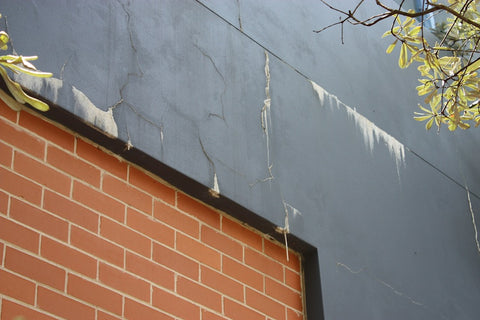Without damp or water penetration, efflorescence cannot occur. Efflorescence is caused by a concentration of salts that have been dissolved by moisture and transported by capillary action to a point of discharge where the moisture evaporates, and leaves the salts behind.
Water is the most destructive compound that works against the health and longevity of any building, in so many different ways other than just efflorescence. Therefore, a quality building specification must always pay careful attention to preventing the ingress of water and damp in every situation.
For over a decade, a cement rendered and painted finish has been very popular in Australia. Render has often been applied to renovate face brickwork that is out of step with current trends. Render is sometimes also used incorrectly to try and address or aesthetically solve other problems such as spalling of bricks and mortar caused by salt attack, (but that is a whole other story).
Render is a form of concrete, generally applied to common brickwork. Like any concrete, it shrinks and leaves shrinkage cracks. Shrinkage cracks can be exacerbated in new construction when render is applied to new clay bricks. Clay bricks leave a kiln with no moisture content, and slowly expand as they regain equalibrium moisture with their surroundings. Like any other fabric of a building, the masonry to some extent will always be dynamic, forever reacting with changes temperature and humidity.
Efflorescence is common in render. Most often it is due to water entering a control joint, or through a paint layer that has cracked with the render's shrinkage cracks. Normal exterior grade paints are thin with no elasticity, so they move with the render and allow water to be absorbed. Ordinary render is incredibly porous, so a tiny crack can draw enormous amounts of water into the wall with capillary action. Elastomeric paints are capable of bridging small cracks, so they should be used on any rendered surfaces that are subject to weather exposure. Control joints should be properly detailed against water ingress with a suitably flexible and paintable sealant such as Polyurethane or MS Polymer, and a backing rod.
An additive such as Efflock in the render is a worthy consideration to prevent the "sponge" effect. Efflock not only gives another barrier against water entry if the paint system degrades, but even more importantly, it will prevent salt damage that can effect the paint system from behind. This situation most often occurs below the damp proof course (DPC), where ground salts are absorbed into the render from rising damp. Over a period of time, the salts build to a point where they start to cause blistering of the paint and spalling of the render through the action of crystallisation. Salt can exert expansion pressures with the pores of masonry that exceed 200 MPa. Salt attack can be prevented below the DPC with 3 measures: 1. Exposure grade bricks. 2. Efflock in the brick mortar. 3. Efflock in the render.
Royal Hospital for Women in Sydney.

